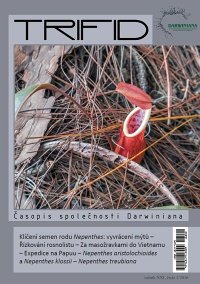Trifid 2016/2
- volume 21
- ISSN 1214-4134
- pages 44
- closing date 31.08.2017
Hunting for Carnivorous Plants in Vietnam
Martin Holík
I was riding an old ramshackle motorbike with my girlfriend behind my back on a dug up road. Grains of sand were grating between my teeth and wind sometimes blew it into my eyes too. I swore for myself as well as aloud. And it started to rain to make things worse. There in Vietnam sun and rain was changing constantly but it couldn´t discourage me. I had to find them! I had to find my pitcher plants that I dreamt of! And then my girlfriend shouted: “There they are! There they are!”
Germinating Nepenthes seed: Putting Myths to Rest
Mason McNair, Jeremiah Harris
The Internet is full of personal accounts and guides on how to grow Nepenthes from seed. However, there is also a plethora of misinformation available. Many of these myths involve the treatment of Nepenthes seeds before they are sown. In particular, whether they require a dark period in order to induce germination. But no conclusive study has been published on this claim. The final claim is that sowing seeds and putting the pot on top of a heat mat will increase germination. Again, no study has been published legitimizing this claim. This study is an attempt to put many of these myths to rest. The authors hypothesize that none of the treatments will yield better results than the control treatment.
Propagating Drosophyllum from Cuttings
Mark S. Anderson
Some years back Mark saw a short article in the CPN 1988 where Richard Tilbrooke described how he had taken some of the plantlets that are often formed on the old flower stalks of Drosophyllum lusitanicum and rooted them into new plants. However, it seems that to reproduce that feat is harder than you would think as the plantlets tend to slowly die when cut from the mother plant and placed in moist growing medium. Still, there had to be a way and the author found it.
An Expedition to Papua
Stewart McPherson
In December 2007, Stew had the opportunity to visit the province of Papua as part of a research assignment organized by Trubus to study the little known species of pitcher plants of that part of Indonesia. Located to the north of Australia across the Torres Strait, New Guinea is a land of remarkable diversity of its peoples, plants and animals. It constitutes less than 1 % of the total land mass of our world, however is home to 10% of the total number of species on the planet, so represents a region of extraordinary natural wealth. The island is divided approximately in half, the western part comprises the Indonesian provinces of Papua and West Papua whereas the eastern half consists of the independent country of Papua New Guinea.
Nepenthes aristolochioides and Nepenthes klossii – Two of Indonesia’s Most Remarkable Plants
V Indonésii rostou dva velice zvláštní druhy láčkovek. Nepenthes aristolochioides je poměrně dobře známým endemitem ostrova Sumatra. Nicméně Nepenthes klosii roste pouze v indonéské provinci Papua na Nové Guineji a je zdokumentována jen velice málo. Oba druhy jsou unikátní díky svým vysoce specializovaným pastem, které pro lov členovců využívají světlo.
Nepenthes treubiana – One of Indonesia’s Most Spectacular Pitcher Plants
After failing to find one of Indonesia’s largest and most spectacular pitcher plants in 2007, Stew set out again in 2008 to attempt to locate the illusive plant. The species which he sought, is Nepenthes treubiana, a little known pitcher plant which grows only on remote cliffsides along the coast of New Guinea, but little information exists on the ecology or general appearance of the plant.
